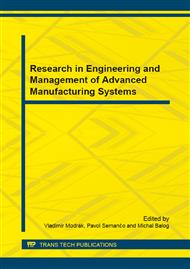[1]
A. Panda. et. all., Accompanying phenomena in the cutting zone machinability during turning of stainless steels., Int. Journal Mach. and Machinability of Mat., INDERSCENCE Publisher, Switzerland. 5, 4, 2009, 383-400.
DOI: 10.1504/ijmmm.2009.026899
Google Scholar
[2]
A. Panda, J. Duplák, J. Jurko, M. Behún, Comprehensive Identification of Sintered Carbide Durability in Machining Process of Bearings Steel 100CrMn6, 2011. In: Advanced Materials Research. Vol. 340 (2011), pp.30-33. - ISSN 1022-6680.
DOI: 10.4028/www.scientific.net/amr.340.30
Google Scholar
[3]
E. Isakov, Cutting Data for turning of steel, Industrial Press, Inc. 989 Avenue of the Americas New York, NY 10018, p.316, 2009, ISBN 978 – 0 – 8311- 3314-6.
Google Scholar
[4]
E.D. Whitney, Ceramic Cutting Tools, William Andrew Publishing/Noyes, p.353, 1994, ISBN 978-0-8155-1355-0.
Google Scholar
[5]
J. Duplák, I. Orlovský, M. Čuma, Comprehensive expression of durability for the selected cutting tools in comparison with standard ISO 3685, 2013.: Advanced Science Letters. 19, 2 (2013), 460-463.
DOI: 10.1166/asl.2013.4745
Google Scholar
[6]
J. Zajac. et. al., Cutting facilities of new type of came cutting material, Proceedings of the conference PPTO, Košice, 1995, 138-139.
Google Scholar
[7]
J. Zajac, D. Mitaľ, P. Michalik: Verification of process fluids in mass production, 2014. In: Key Engineering Materials. 581 (2014),. 554-559.
DOI: 10.4028/www.scientific.net/kem.581.554
Google Scholar
[8]
K. Vasilko, J. Duplák, Realistic Dependence T-vc for Recent Cutting Materials , 2013. In: Manufacturing Technology. 13, 4 (2013), 568-571.
DOI: 10.21062/ujep/x.2013/a/1213-2489/mt/13/4/568
Google Scholar
[9]
M. Cuma, M. Janak, The impact of cutting fluids on machining, 2009. In: ICPM 2009. - Prešov FVT TU, 2009, 25-30.
Google Scholar
[10]
M. Kočiško, J. Novák-Marcinčin, P. Baron, J. Dobránsky: Utilization of progressive simulation software for optimization of production systems in the area of small and medium companies TehnickiVjesnik, 19(2012) 983-986.
Google Scholar
[11]
P. Michalik, J. Zajac, Intelligently programming of holes machining, In: Manufacturing Technologies . 9, 4 (2010), 63-65.
Google Scholar
[12]
P. Semanco, M. Fedak, M. Rimar, Simulation study of two alternative workstations for pressure diecasting process, Applied Mechanics and Materials, 110-116(2012), 660-664.
DOI: 10.4028/www.scientific.net/amm.110-116.660
Google Scholar
[13]
R. Čep, A. Janásek, J. Petru, M. Sadílek, P. Mohyla, J. Valíček, M. Harničárová, A. Czán, Surface roughness after machining and influence of feed rate on process, 2014. In: Key Engineering Materials. 581 (2014), 341-347.
DOI: 10.4028/www.scientific.net/kem.581.341
Google Scholar
[14]
Z. Hutyrová, J. Zajac, V. Fečová: Machining of non-homogeneous composite material with natural fibers reinforcement and HDPE matrix 2014. In: Key Engineering Materials. 581 (2014), 95-99.
DOI: 10.4028/www.scientific.net/kem.581.95
Google Scholar
[15]
R. Hudák, M. Šarik, R. Dadej, J. Živčák, D. Harachová, Material and thermal analysis of laser sinterted products. ActaMechanicaetAutomatica. 7, 1 (2013), 15-19.
DOI: 10.2478/ama-2013-0003
Google Scholar
[16]
D. Stančeková, A. Czán, M. Derbas, Investigation of defects in forging tools by nondestructive detection method. In: METAL 2013 - 22nd international conference on metallurgy and materials : conference proceedings, Brno, Czech Republic, EU. - Ostrava: TANGER Ltd., 2013, 485 – 490.
Google Scholar


